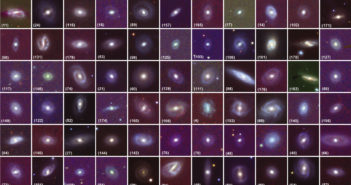
Featured Image: Identifying Weird Galaxies
Citation
Ian Timmis and Lior Shamir 2017 ApJS 231 2. doi:10.3847/1538-4365/aa78a3

Ian Timmis and Lior Shamir 2017 ApJS 231 2. doi:10.3847/1538-4365/aa78a3
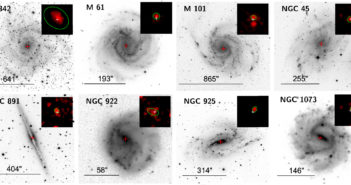
The images above show just 8 of 51 different nearby, late-type galaxies found to host X-ray cores near their centers. The main images are optical views and the insets show Chandra X-ray images of the same galaxies. The cross marks identify the near-infrared/optical nucleus of each galaxy, and the green ellipses show the source regions for the X-rays. A recent publication led by Rui She (Tsinghua University, China) presents a search for low-mass (<106 solar masses) black holes lurking in the centers of nearby late-type, low-mass galaxies. Many of the 51 X-ray cores discovered represent such hidden black holes. The authors use the statistics of this sample to estimate that at least 21% of late-type galaxies like those studied here host low-mass black holes at their centers. You can view the full set of X-ray core hosts below; for more information, check out the paper linked at the bottom of the page.
Rui She et al 2017 ApJ 842 131. doi:10.3847/1538-4357/aa7634

Planning on watching fireworks tomorrow? Here’s an astronomical firework to help you start the celebrations! A new study has stunningly detailed the Crab Nebula (click for a closer look), a nebula 6,500 light-years away thought to have been formed by a supernova explosion and the subsequent ultrarelativistic wind emitted by the pulsar at its heart. Led by Gloria Dubner (University of Buenos Aires), the authors of this study obtained new observations of the Crab Nebula from five different telescopes. They compiled these observations to compare the details of the nebula’s structure across different wavelengths, which allowed them to learn about the sources of various features within the nebula. In the images above, the top left shows the 3 GHz data from the Very Large Array (radio). Moving clockise, the radio data (shown in red) is composited with: infrared data from Spitzer Space Telescope, optical continuum from Hubble Space Telescope, 500-nm optical data from Hubble, and ultraviolet data from XMM-Newton. The final two images are of the nebula center, and they are composites of the radio image with X-ray data from Chandra and near-infrared data from Hubble. To read more about what Dubner and collaborators learned (and to see more spectacular images!), check out the paper below.
G. Dubner et al 2017 ApJ 840 82. doi:10.3847/1538-4357/aa6983


ALMA continuum image overlaid as contours on the Hubble STIS image of Fomalhaut. [MacGregor et al. 2017]
Meredith A. MacGregor et al 2017 ApJ 842 8. doi:10.3847/1538-4357/aa71ae
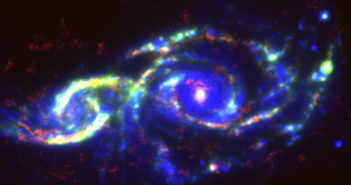
This beautiful image shows two galaxies, IC 2163 and NGC 2207, as they undergo a grazing collision 114 million light-years away. The image is composite, constructed from Hubble (blue), Spitzer (green), and ALMA (red) data. In a recent study, Debra Elmegreen (Vassar College) and collaborators used this ALMA data to trace the individual molecular clouds in the two interacting galaxies, identifying a total of over 200 clouds that each contain a mass of over a million solar masses. These clouds represent roughly half the molecular gas in the two galaxies total. Elmegreen and collaborators track the properties of these clouds and their relation to star-forming regions observed with Hubble. For more information about their observations, check out the paper linked below.
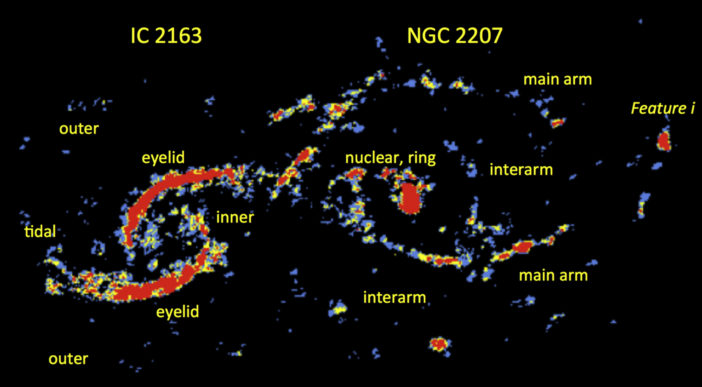
A closer look at the ALMA observations for these galaxies, with the different emission regions labeled. Most of the molecular gas emission comes from the eyelids of IC 2163, and the nuclear ring and Feature i in NGC 2207. [Elmegreen et al. 2017]
Debra Meloy Elmegreen et al 2017 ApJ 841 43. doi:10.3847/1538-4357/aa6ba5

This dynamic image of active region NOAA 12241 was captured by the Solar Dynamics Observatory’s Atmospheric Imaging Assembly in December 2014. Observations of this region from a number of observatories and instruments — recently presented by Jincheng Wang (University of Chinese Academy of Sciences) and collaborators — reveal details about the formation and eruption of a long solar filament. Wang and collaborators show that the right part of the filament formed by magnetic reconnection between two bundles of magnetic field lines, while the left part formed as a result of shearing motion. When these two parts interacted, the filament erupted. You can read more about the team’s results in the article linked below. Also, check out this awesome video of the filament formation and eruption, again by SDO/AIA:
Jincheng Wang et al 2017 ApJ 839 128. doi:10.3847/1538-4357/aa6bf3
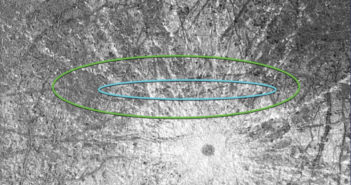

Nighttime thermal image from the Galileo Photopolarimeter-Radiometer, revealing a thermal anomaly around the region where the plumes were observed. [Sparks et al. 2017]
W. B. Sparks et al 2017 ApJL 839 L18. doi:10.3847/2041-8213/aa67f8
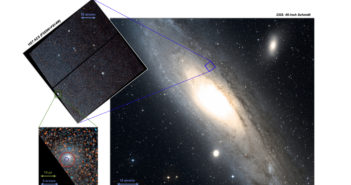
This image (click for a closer look!) reveals the sky location of a new discovery: the slowest spinning X-ray pulsar — a spinning, highly magnetized neutron star — ever found in an extragalactic globular cluster. The pulsar, XB091D (circled in the bottom left inset), lies in the globular cluster B091D in the Andromeda galaxy. In a recent study led by Ivan Zolotukhin (University of Toulouse, Moscow State University, and Special Astrophysical Observatory of the Russian Academy of Sciences), a team of scientists details the importance of this discovery. This pulsar is gradually spinning faster and faster — a process that’s known as recycling, thought to occur as a pulsar accretes material from a donor star in a binary system. Zolotukhin and collaborators think that this particular pairing formed relatively recently, when the pulsar captured a passing star into a binary system. We’re now seeing it in a unique stage of evolution where the pulsar is just starting to get recycled. For more information, check out the paper below!
Ivan Yu. Zolotukhin et al 2017 ApJ 839 125. doi:10.3847/1538-4357/aa689d

This figure (click for the full view) shows the meridional galactic orbits of 12 globular clusters that orbit the Milky Way. The recent release of stellar parallax data from Gaia allowed a team of scientists at Dartmouth College to improve measurements of a number of galactic globular clusters — very old clusters of stars that can either orbit within the galactic disk and bulge or more distantly in the galactic halo. In a recent publication led by Erin O’Malley, the team presents their findings and combines their new measurements for the clusters with proper motions from past studies to calculate the orbits that these globulars take. These calculations show us whether the clusters reside in the galactic disk and bulge (as only NGC 104 does in the sample shown here, since its orbit is confined to 8 kpc radially and 4 kpc vertically of the galactic center), or if they are halo clusters. To learn more about the authors’ work, you can check out the paper below!
Erin M. O’Malley et al 2017 ApJ 838 162. doi:10.3847/1538-4357/aa6574

This image shows a snapshot from a simulation of a relativistic binary black hole system. A recent study led by Dennis Bowen (Rochester Institute of Technology) presents the first exploration of gas dynamics in relativistic binary black hole systems in which each black hole is surrounded by its own small accretion disk. Bowen and collaborators use their 2D hydrodynamical simulations to explore how gas is passed back and forth between the two “mini-disks” as the black holes orbit each other. They also examine what kind of distinctive observable signals might be caused by this “sloshing” and by tidally driven spiral waves in the disks. To read more about their outcomes, check out the article below!
Dennis B. Bowen et al 2017 ApJ 838 42. doi:10.3847/1538-4357/aa63f3